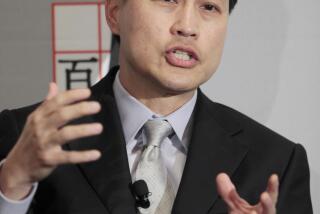Japanese Profit From Mistakes of U.S. Banks
The investment by Dai-Ichi Kangyo, Japan’s largest bank, in Manufacturers Hanover, the United States’ seventh largest--and Dai-Ichi’s $1.3-billion purchase of a controlling interest in Manufacturers’ CIT Finance subsidiary--is the start of a major trend.
Depend on it, more Japanese capital will be flowing into the U.S. finance industry--not so much to buy U.S. lending institutions as to take markets and customers from them, because Japanese banks have plenty of money while U.S. banks have been weakened by a decade of bad loans.
That contrast of capital strength and weakness is the key to understanding what lies ahead for U.S. banks--and U.S. borrowers. For the banks it means merging with each other or forming alliances to strengthen their finances or to hold markets.
For borrowers it means more money available in the marketplace--”greater competition, and thus a lower cost to the consumer,” says James McDermott, research chief of Keefe, Bruyette & Woods Inc., a New York firm specializing in bank securities.
Effort to Raise Equity
Yet as the flow of Japanese money increases, you’re sure to hear cries of alarm about Japan’s hold on U.S. business and America’s loss of financial leadership. But the fear and despair will be overstated, so perspective is necessary.
To understand what is happening, think back to the time 10 years ago when money was flowing out of the oil-rich Middle East and being recycled in loans to Latin America and other poor nations. That’s where the process began that led to Dai-Ichi’s investment this week.
The reason Manufacturers Hanover (nicknamed Manny Hanny) sold 60% of its profitable CIT subsidiary was that it had to raise money to boost reserves against its $6.8 billion in loans to Latin America. It also sold 5% of its stock to Dai-Ichi as part of an effort to raise equity and comply with tightened U.S. government rules on how much capital banks must hold.
Manny Hanny is one of the weakest U.S. big banks, but by no means alone in having to boost reserves and raise capital. Banks everywhere, including Japan, made loans to Latin American governments and private companies. But U.S. banks led the way, because the U.S. government had the responsibility, as world leader, to recycle the petrodollars and keep the global economy going. One result has been billions in troubled loans on the books of U.S. banks: $8.85 billion at Citicorp, $7.4 billion at BankAmerica, $6.4 billion at Chase Manhattan.
Now more of those loans are being written off, which reduces the banks’ capital and their capacity to lend. As a consequence, the next few years for U.S. banks will be a time of rebuilding--a period, as baseball and football fans know, when the team is seldom strong enough to win a championship.
$400 Billion in Assets
Meanwhile the Japanese banks, which lent mostly to Japan’s growing industry in the last decade, are capital heavyweights. By one calculation, that of their value on the Tokyo stock market, the 13 largest banks in Japan are worth $500 billion. By contrast, the market value of the 50 largest U.S. banks is less than $100 billion.
The comparison is no exaggeration--one leading U.S. banker puts the equity value of a single major Japanese bank at more than $350 billion. And you don’t have to be an accountant to understand that banks that have a lot of money behind them have a competitive advantage over banks that do not.
Which makes Dai-Ichi’s purchase of CIT interesting, because the finance company is a lender to medium-sized companies. It has about $10 billion in loans outstanding to firms with sales of $250 million or so--the profitable heart of U.S. business for a finance company.
And Dai-Ichi--a massive bank with $400 billion in assets (almost double Citicorp’s size)--has had its eye on that market. A few years ago, Dai-Ichi paid about $1 million to buy a U.S. operation that served medium-sized companies. “We wanted to learn the middle market,” explained Koji Takahashi, a bank senior director, in a recent Tokyo interview.
Having learned it, Dai-Ichi followed up this week with its $1.3-billion CIT investment.
To U.S. bank competitors, Japanese ownership will matter. It’s one reason you’ll see many of the 1,400 U.S. banks merging to attain greater size. “They’ll have to do something or see business go to the Japanese,” notes analyst McDermott.
But does it make a difference to borrowers that the lenders are foreign? Not really. The money market is now global; the more lenders vie for their business, the better it is for U.S. borrowers.
In any case, says a leading U.S. financier, when U.S. banks had lots of money 10 years ago they preferred to lend to foreign governments rather than U.S. companies. Now the banks are paying for that mistake, but the rest of U.S. business need not.
More to Read
Inside the business of entertainment
The Wide Shot brings you news, analysis and insights on everything from streaming wars to production — and what it all means for the future.
You may occasionally receive promotional content from the Los Angeles Times.










